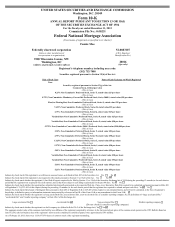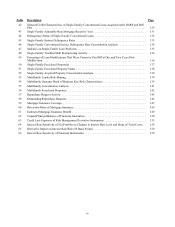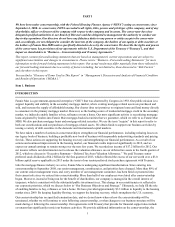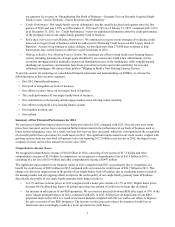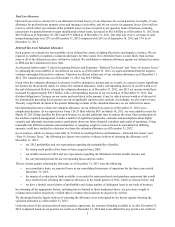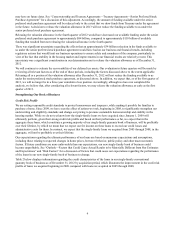Fannie Mae 2012 Annual Report Download - page 10
Download and view the complete annual report
Please find page 10 of the 2012 Fannie Mae annual report below. You can navigate through the pages in the report by either clicking on the pages listed below, or by using the keyword search tool below to find specific information within the annual report.5
Total Loss Reserves
Our total loss reserves consist of (1) our allowance for loan losses, (2) our allowance for accrued interest receivable, (3) our
allowance for preforeclosure property taxes and insurance receivables, and (4) our reserve for guaranty losses. Our total loss
reserves, which reflect our estimate of the probable losses we have incurred in our guaranty book of business, including
concessions we granted borrowers upon modification of their loans, decreased to $62.6 billion as of December 31, 2012 from
$66.9 billion as of September 30, 2012 and $76.9 billion as of December 31, 2011. Our total loss reserve coverage to total
nonperforming loans was 25% as of December 31, 2012 compared with 26% as of September 30, 2012 and 31% as of
December 31, 2011.
Deferred Tax Asset Valuation Allowance
Each quarter, we evaluate the recoverability of our deferred tax assets, weighing all positive and negative evidence. We are
required to establish or maintain a valuation allowance for these assets if we determine that it is more likely than not that
some or all of the deferred tax assets will not be realized. We established a valuation allowance against our deferred tax assets
in 2008 and have maintained it since then.
As discussed further under “Critical Accounting Policies and Estimates—Deferred Tax Assets” and “Note 10, Income Taxes,”
in evaluating the recoverability of our deferred tax assets, as of December 31, 2012, we again determined that the negative
evidence outweighed the positive evidence. Therefore we did not release any of our valuation allowance as of December 31,
2012. The valuation allowance as of December 31, 2012 was $58.9 billion.
If and when the valuation allowance is released, it will be included as income and, as a result, we expect to report significant
net income for the period in which we release the valuation allowance, with a corresponding increase in our net worth as of
the end of that period. Had we released the valuation allowance as of December 31, 2012, our 2012 net income would have
increased by approximately $58.3 billion, with a corresponding increase in our net worth as of December 31, 2012. Our
dividend obligation to Treasury on our senior preferred stock is the amount, if any, by which our net worth as of the end of
the immediately preceding fiscal quarter exceeds an applicable capital reserve amount. Accordingly, we also expect to pay
Treasury a significant dividend in the quarter following a release of the valuation allowance on our deferred tax assets.
Our determination not to release the valuation allowance on our deferred tax assets as of December 31, 2012 was a
complicated decision. As we reported in a Form 12b-25 filed with the SEC on March 14, 2013, we were unable to meet the
March 18, 2013 filing deadline for this report because we needed additional time to analyze the issue. Our consideration of
the evidence required management to make a number of significant judgments, estimates and assumptions about highly
complex and inherently uncertain matters, particularly about our future financial condition and results of operations. Using
reasonable but different estimates and assumptions, or assigning weight to various factors in reasonable but differing
amounts, could have resulted in a decision to release the valuation allowance as of December 31, 2012.
In our analysis, which we discuss more fully in “Critical Accounting Policies and Estimates—Deferred Tax Assets” and
“Note 10, Income Taxes,” the following key factors were positive evidence in favor of releasing the allowance as of
December 31, 2012:
• our 2012 profitability and our expectations regarding the sustainability of profits,
• the strong credit profile of the loans we have acquired since 2009,
• our taxable income for 2012 and our expectations regarding the likelihood of future taxable income, and
• the carryforward periods for our net operating losses and tax credits.
The key factors against releasing the allowance as of December 31, 2012 were the following:
• on a cumulative basis, we reported losses in our consolidated statements of operations for the three years ended
December 31, 2012;
• the impact of a reduction in funds available to us under the senior preferred stock purchase agreement that would
have resulted from releasing the valuation allowance in the fourth quarter of 2012, which we discuss below; and
• we have a limited recent history of profitability and a large number of delinquent loans in our book of business.
In evaluating all the appropriate factors, including but not limited to those mentioned above, we gave more weight to
evidence that could be objectively verified than to evidence that could not be objectively verified.
We determined that the factors in favor of releasing the allowance were outweighed by the factors against releasing the
valuation allowance as of December 31, 2012.
Under the terms of the senior preferred stock purchase agreement, the amount of funding available to us after December 31,
2012 is adjusted based on our positive net worth as of December 31, 2012 and is not affected by any positive net worth we

